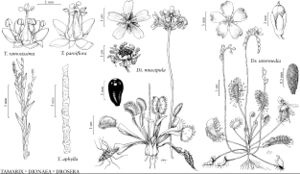Dionaea
St. James’s Chron. Brit. Eve. Post 1172: [4]. 1768.
| Taxon | Illustrator ⠉ | |
|---|---|---|
 | Tamarix aphylla Tamarix parviflora Tamarix ramosissima Dionaea muscipula Drosera intermedia | Yevonn Wilson-Ramsey Yevonn Wilson-Ramsey Yevonn Wilson-Ramsey Linny Heagy Linny Heagy |
Plants perennial, evergreen; scapes from bulblike rhizomes encased in fleshy petiole bases; leaves persisting, not forming overwintering buds (hibernaculae). Roots adventitious, white, unbranched. Leaves: stipules absent; petiole winged; blade greenish or bright red adaxially, of 2 subreniform, hinged lobes, margins with stout bristles (hinged along midrib, adaxial surfaces with 3 trigger hairs causing lobes to snap shut on prey when properly stimulated). Inflorescences umbellike cymes. Flowers: petals marcescent, white; stamens (10–) 15 (–20), distinct; gynoecium 5-carpellate; style 1, not divided; stigma plumose. Capsules ovoid, opening irregularly. Seeds (20–) 25 (–30). x = 16.
Distribution
United States, elsewhere
Discussion
Species 1.
Dionaea has been placed in its own family, Dionaeaceae Rafinesque. This is not without merit, as virtually all of its diagnostic features are different from those of Drosera. Molecular analysis places it in the Droseraceae in the narrow sense (K. M. Cameron et al. 2002; S. E. Williams et al. 1994; F. Rivadavia et al. 2003).